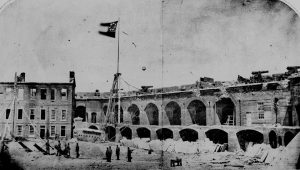SURRENDER OF FORT SUMTER: THE REST OF THE STORY
Posted By : manager
Posted : February 26, 2022
By: Mike Thomas
History books have long recorded the firing on Fort Sumter by Confederate forces on April 12, 1861, and its surrender the next day. They usually mention surrender terms allowed the U.S. garrison to conduct a 100-gun salute before lowering the U.S. garrison flag and departing the fort on April 14. Some go further by noting the salute became marred when a man was killed by a premature explosion of a cannon. But there is even more to this story. The blast occurred on the 43rd shot (some sources state the 47th) of the salute when a powder charge rammed into a cannon was ignited by sparks that blew into the barrel from fires at the fort.
The resulting explosion ignited cartridges nearby, resulting in another fire and explosions sending men tumbling through the air. This tragic accident led to the salute being halted at 50 shots, with the carnage dampening the event’s mood. Private Daniel Hough was killed almost instantly, and five others sustained injuries. Private Edward Gallo-way was taken to a Charleston hospital with severe wounds and died a week later. Private James Fielding was also hospitalized with wounds and burns in“Fort Sumter,” Charleston. He eventually recovered from his injuries and was “sent north without exchange.” The other three injured men could depart the fort with the garrison.

Private Hough has been buried on Fort Sumter’s parade ground by the U.S. garrison before it departed the fort. His body was not carried away when the garrison departed is not explained. However, numerous efforts by his family to recover his remains have been fruitless. There is speculation the Confederates later removed him to a cemetery on Sullivan’s Island or perhaps the St. Lawrence Cemetery in Charleston. Some think his grave remained at Fort Sumter but was “lost” in the fort’s 1863-1864 Union bombardments. Unfortunately, his final resting site remains a mystery. Hough, an Irish immigrant who arrived in New York in 1849 and immediately enlisted in the army, is generally recognized as the first casualty of the war. Private Galloway’s remains are also unknown despite numerous efforts to find his grave. Historians consider Galloway the first man to be mortally wounded in the battle.